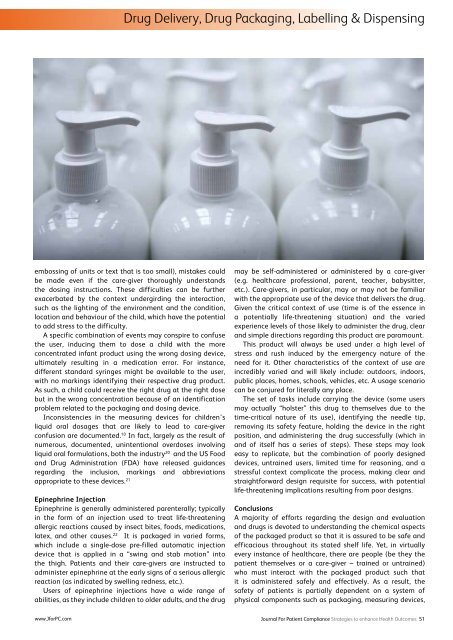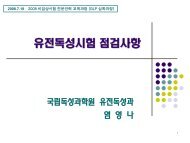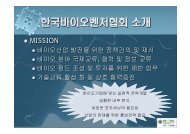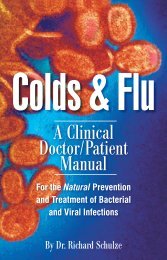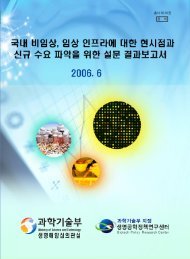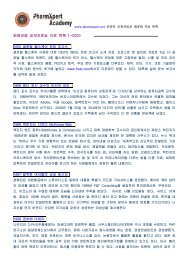Drug Delivery, Drug Packaging, Labelling & DispensingThe combination and adaptation of the existing modelsprovides a framework regarding the needs, abilities, anddesires of users with diverse goals in varied contexts. It canbe used to inform the consideration set of variables whichhave the potential to influence adherence when designingfor, or evaluating, package performance.Further, these interactions can be described as an iterativeloop that consists of perception, mental processing, andaction that occurs within a particular context when anindividual needs to perform a specific task (or series of tasks)with a packaged product (see Figure 2). The interaction isa cyclic process in which user’s actions may cause effectsleading to a new state of things, and perception is then reevaluatedin terms of user’s goals.Figure 2: Human-package interaction framework. Adapted from Shackel,Card, and Monk. 15-17Application to Healthcare ProductsDesigners that employ a user-centred design approach willidentify users’ characteristics, contexts of use, and tasksassociated with a healthcare product in order to optimiseperformance. For evaluation and testing purposes, this toolcan be used to define testing conditions and compose userpanels. Contextual conditions for testing include: the physicalenvironment, lighting, temperature, noise, and distractions,for example.For design and development, the framework can supportseveral design research activities such as user observation,ethnography, task analysis, context of use analysis, productbenchmarking, and so on. During design phases like conceptgeneration, prototyping, and testing, designers and engineershave the potential to account for a variety of factorsaffecting the usability of healthcare products. Furthermore,key design strategies are likely to be generated by analysingand prioritising such factors.The model can be used to guide and verify assumptionsregarding the product and the target audience. Designersshould observe and interview actual users carefully in orderto incorporate insights about product use and verify theirassumptions in an ecologically valid context. The nextsections illustrate potential problems of adherence andmedication errors that would benefit from a more usercentredapproach to design.To accomplish this, we use two healthcare products (seeTable 2)Table 2: Summary breakdown of users, contexts of use and tasks for twocommon healthcare productsa) Infant’s and children’s ibuprofen: a situation dealing withdosing and drug identification issues.b) Epinephrine injection: a situation of emergency use.Infant’s and Children’s IbuprofenIbuprofen is a non-steroidal anti-inflammatory (NSAID)analgesic antipyretic (lowers body temperature withoutimpairing consciousness) that, at higher doses, reducesinflammation. Our example utilises two formulations, onefor infants and a second for children, both with the activeingredient ibuprofen. The infant formulation consists ofa concentrated liquid oral (50 mg per 1.25 mL)19 and isintended for infants aged up to 23 months. Children’sibuprofen is also an oral suspension. Its concentration is100 mg of active per 5 mL19 and it is intended for childrenbetween 2 and 11 years of age. Both products are supplied inbottles. Each product has a specific dosing device: a standardsyringe for the infant product and a thermoformed plasticcup for the children’s version.The user of either product is not likely to be the actualpatient. It may be a parent, a grandparent, a babysitter, ora healthcare professional. Designers will have to considerusers with different levels of education, and a broad rangeof abilities (i.e., perceptual, cognitive, and physical) andexperience.Varied contexts of use include different rooms of a house(e.g., bathroom, kid’s bedroom, kitchen, and so on) or evenan on-the-go situation (e.g., car, other house, a public place,etc). In the worst case scenarios, light might be inadequate,for example, because it’s late at night and parents simply donot want to awaken the child.Typical tasks include storing, identifying the correctproduct from among many, locating and understandingcorrect dosage information, opening child-resistant packages,dispensing and measuring by means of a dosing device,reclosing, and, eventually, disposal. The challenge is tosimultaneously consider the factors presented in the model inorder to optimise the likelihood of successful administrationof the product. For instance, locating and comprehending thecorrect dose might be particularly challenging for users notfamiliar with metric units or not formally trained regardingmedications, but may be readily understood by those whoare.If the dosing device is designed in such a fashion thatit is difficult to perceive (e.g. poor contrast, inadequate50 Journal For Patient Compliance Strategies to enhance Adherence and Health OutcomesVolume 2 - Issue 4
Drug Delivery, Drug Packaging, Labelling & Dispensingembossing of units or text that is too small), mistakes couldbe made even if the care-giver thoroughly understandsthe dosing instructions. These difficulties can be furtherexacerbated by the context undergirding the interaction,such as the lighting of the environment and the condition,location and behaviour of the child, which have the potentialto add stress to the difficulty.A specific combination of events may conspire to confusethe user, inducing them to dose a child with the moreconcentrated infant product using the wrong dosing device,ultimately resulting in a medication error. For instance,different standard syringes might be available to the user,with no markings identifying their respective drug product.As such, a child could receive the right drug at the right dosebut in the wrong concentration because of an identificationproblem related to the packaging and dosing device.Inconsistencies in the measuring devices for children’sliquid oral dosages that are likely to lead to care-giverconfusion are documented. 10 In fact, largely as the result ofnumerous, documented, unintentional overdoses involvingliquid oral formulations, both the industry 20 and the US Foodand Drug Administration (FDA) have released guidancesregarding the inclusion, markings and abbreviationsappropriate to these devices. 21Epinephrine InjectionEpinephrine is generally administered parenterally; typicallyin the form of an injection used to treat life-threateningallergic reactions caused by insect bites, foods, medications,latex, and other causes. 22 It is packaged in varied forms,which include a single-dose pre-filled automatic injectiondevice that is applied in a “swing and stab motion” intothe thigh. Patients and their care-givers are instructed toadminister epinephrine at the early signs of a serious allergicreaction (as indicated by swelling redness, etc.).Users of epinephrine injections have a wide range ofabilities, as they include children to older adults, and the drugmay be self-administered or administered by a care-giver(e.g. healthcare professional, parent, teacher, babysitter,etc.). Care-givers, in particular, may or may not be familiarwith the appropriate use of the device that delivers the drug.Given the critical context of use (time is of the essence ina potentially life-threatening situation) and the variedexperience levels of those likely to administer the drug, clearand simple directions regarding this product are paramount.This product will always be used under a high level ofstress and rush induced by the emergency nature of theneed for it. Other characteristics of the context of use areincredibly varied and will likely include: outdoors, indoors,public places, homes, schools, vehicles, etc. A usage scenariocan be conjured for literally any place.The set of tasks include carrying the device (some usersmay actually “holster” this drug to themselves due to thetime-critical nature of its use), identifying the needle tip,removing its safety feature, holding the device in the rightposition, and administering the drug successfully (which inand of itself has a series of steps). These steps may lookeasy to replicate, but the combination of poorly designeddevices, untrained users, limited time for reasoning, and astressful context complicate the process, making clear andstraightforward design requisite for success, with potentiallife-threatening implications resulting from poor designs.ConclusionsA majority of efforts regarding the design and evaluationand drugs is devoted to understanding the chemical aspectsof the packaged product so that it is assured to be safe andefficacious throughout its stated shelf life. Yet, in virtuallyevery instance of healthcare, there are people (be they thepatient themselves or a care-giver – trained or untrained)who must interact with the packaged product such thatit is administered safely and effectively. As a result, thesafety of patients is partially dependent on a system ofphysical components such as packaging, measuring devices,www.JforPC.comJournal For Patient Compliance Strategies to enhance Health Outcomes 51


